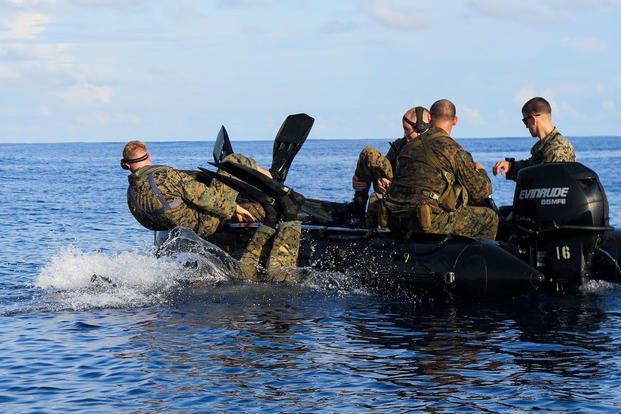There are often questions concerning some of the details of swimming with fins that watching a video does not answer. Here are some of the best questions of the week to help clear up confusion when it comes to swimming with fins and taking PT tests.
My answers are in italics under your questions:
When flutter-kicking, should I be pushing up with my toes to move the fins, or should my foot be in line with my leg and have my ankle do all the work?
Your foot should look like a ballerina's point when swimming with fins. Do not flex your foot with fins. It is all hips, hamstrings, thighs and relaxed feet (otherwise, you will cramp quickly).
Should I keep my ankle rigid? It's hard to articulate what I am trying to get at, so hopefully you know what I mean. Just found my ankles to be very tired after a few laps, so I don't know if it's just improper form or if it just needs some strengthening.
Stew Smith, Military.com's tactical fitness expert, demonstrates swimming with fins.
Keep it pointed. It takes about a month to get used to the pain on your ankles and feet when swimming with fins. It will go away once you have amassed some time in the water while wearing fins.
Should I try to keep the fins entirely under water and eliminate any splashing on the surface, or is this not a big concern?
Stay sideways when flutter-kicking or scissor-kicking with fins so your feet do not surface. No splashing. Big concern -- yes.
When watching one of your CSS with fins videos, you mentioned the only time you really need to do the arm portion of the CSS [combat swimmer stroke] is when you need to breathe. So if I only need to breathe twice per length, could I just "glide" while flutter-kicking most of the time?
Yes, but you should and will breathe more than that as you build up distances to the one- to two-mile zone. Typically in a 25-meter pool, you should breathe 3-4 times at least, just so you can maintain that pace for long distances.
Lastly, could I incorporate a scissor kick in there, or is that not necessary?
It's up to you. I do a scissor-kick with little flutter-kicks on my strong side and just medium-sized flutter-kicks on my weak side. That worked for me. Some do all flutter-kicks on both sides; some mix on both sides. I do a bit of both.
Concerning push-ups on the PST. I know you can shake one arm out at a time, but are you allowed to go into a pike to stretch it out, or do you need to keep a plank the whole time?
You cannot shake an arm out anymore. You have to stay in the up push-up position. No pike pose.
Send your questions if you have time. I answer all questions and will anonymously post them if they are relevant and a very commonly asked question that others will benefit from, as well.
Stew Smith is a former Navy SEAL and fitness author certified as a Strength and Conditioning Specialist (CSCS) with the National Strength and Conditioning Association. Visit his Fitness eBook store if you're looking to start a workout program to create a healthy lifestyle. Send your fitness questions to stew@stewsmith.com.
Want to Learn More About Military Life?
Whether you're thinking of joining the military, looking for fitness and basic training tips, or keeping up with military life and benefits, Military.com has you covered. Subscribe to Military.com to have military news, updates and resources delivered directly to your inbox.


















